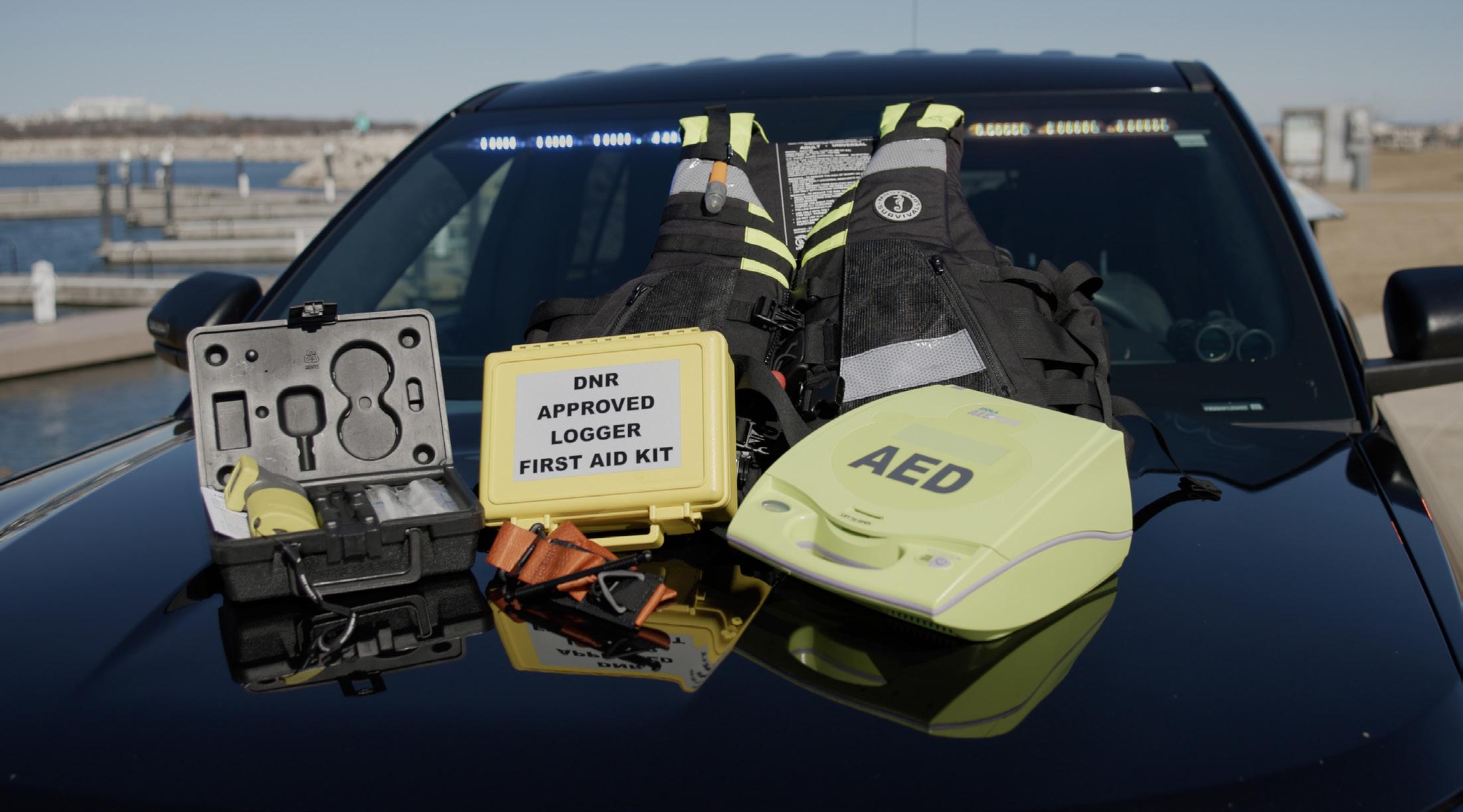
5 minute read
Ready To Serve | AEDs Represent Latest Way DNR Wardens Are Prepared
Joanne M. Haas
Joanne M. Haas is the public information officer for the DNR’s Division of Public Safety and Resource Protection.
Ask Chief Conservation Warden Casey Krueger to name the most significant duty in the public service mission of any DNR conservation warden, and his answer is quick and direct.
“There’s nothing more important than saving a life.”
From the first officers who donned state natural resources law enforcement uniforms in 1879 to the current roster of conservation wardens, public safety has been paramount to everyone wearing the warden badge in Wisconsin. Putting their own lives in danger to help others is done without second thoughts.
Today’s wardens have built upon the skill sets and expertise of their predecessors as they work to protect Wisconsin’s natural resources and ensure those using them make it home safely.
As recreational activities have evolved, so, too, have advancements in emergency response techniques and equipment used by DNR wardens. Arguably, the most important recent expansion of the safety arsenal — the automated external defibrillator, or AED — was spurred by a life-or-death lesson at a cross-country ski race.
Sprint For The AED
It was 2023 when two conservation wardens were stationed with a local ambulance crew at the crowded finish line of the Kortelopet ski race in Hayward, part of the annual American Birkebeiner weekend. Racers were fast approaching when the wardens heard panicked cries for help: Someone was down.
The wardens — Dylan Belisle and Dave Sanda — sprinted to join others aiding the motionless competitor. The team of lifesavers began CPR as unsuspecting skiers powered around them and oblivious race fans clapped and cheered.
Shouts went out that an AED was needed. The device is used to detect and correct life-threatening heart arrythmias.
“We were in front of the post office,” Belisle said, thinking a federal office would have an AED. He ran in but came up empty-handed.
Belisle ran back to the ambulance, which was equipped with an AED — and it was successfully used to save the race competitor’s life.
The lesson? Because much of Wisconsin is rural and a conservation warden may reach an emergency situation before an ambulance — and because seconds can make all the difference for survival — wardens need AEDs.

Lifesaving Teamwork
As of 2025, all DNR wardens are certified in CPR and equipped with their own AED to go wherever the warden goes. That means on the ATV-UTV trails and snowmobile routes, riding the waves on patrol boats, serving visitors in state parks and keeping watch in the rural countryside.
When conservation warden Kyle Ziembo of Marathon County first got his AED in April 2024, he didn’t expect to use it because his service territory has fulltime emergency medical response teams.
“When I found a place to store it in my truck, I assumed it would likely become a fixture that might turn into a shelf,” Ziembo said. But he was wrong.
“Two weeks later, I was on patrol at a Marathon County boat landing with my supervisor, Lt. Bryan Lockman,” Ziembo said. “That’s when we heard the radio transmission of a man experiencing suspected cardiac arrest.”
When the wardens arrived at the rural home, the man’s wife, a trained nurse, was performing CPR.
“We got our AED and raced to the man’s side as he was down in the yard. He had no pulse and was not
breathing,” Ziembo recalled. “We attached the AED and followed the instructions on when to apply a shock to the heart and when to continue the CPR.”
The emergency medical team arrived about 20 minutes later and took over lifesaving measures. The man survived, thanks to the timely care performed by the pair of wardens and the man’s wife during those minutes before the ambulance arrived.

Aid In Remote Areas
Marathon County has plenty of urban areas, but like many parts of the state, there are rural areas as well. Having AEDs helps wardens better serve.
“Conservation wardens may be able to help if a person’s life is on the line,” Ziembo said.
Deputy chief warden Matt O’Brien agreed, saying the statewide AED deployment is about responding fast no matter the terrain.
“It’s about extending the public safety umbrella into some of Wisconsin’s most remote areas, including our forests, lakes, marshes, wilderness areas and recreation trails,” he said.
“By having adequately equipped and trained responders across Wisconsin’s landscape, the warden service is helping to supplement local resources by delivering time-sensitive defibrillation throughout the state’s landscape.”
Other Vital Skills
DNR wardens also are trained in other lifesaving first-aid actions.
In 2023, warden Al Erickson of Iowa County applied a tourniquet to a man who had badly cut himself while using a brush cutter, stemming the bleeding until an ambulance arrived. The man survived.
Wardens are equipped with Naloxone, also known as Narcan, to provide emergency medical care for an opioid overdose. And they’re trained to deal with situations when someone may be contemplating harm to themselves.
Specially trained wardens use drones, off-highway vehicles or remotely operated underwater cameras and sonars to participate in rescue endeavors or to help when a situation might become a recovery effort. These skills can be life-preserving in themselves for responders — more quickly finding a body’s location may reduce the time rescue divers spend in cold or dangerous water conditions.
Wardens who have forensic training and equipment contribute, too, sometimes finding the smallest details to help solve a case. Skills of DNR wardens trained in this way are so valuable, wardens were even asked several years ago to assist in an international boat homicide case in the Cayman Islands.
Just one more way DNR conservation wardens are ready, able — and equipped — to serve.


